“And when the seven thunders spake, I was about to write; but I heard a voice from heaven say, “Seal up what the seven thunders have said and do not write it.”
(Apocalypse of John)
3.1 The general structure of the Tarot
The Tarot is a group of figures, in two subgroups of 22 and 56 cards, called respectively Major Arcana and Minor Arcana. It may seem superfluous to stress this fact, but this subdivision has at times been debated. This, because the history of these images has been so rich in a multiplicity of options, with respect to the actual number of cards and their general configuration. Therefore, not only a unanimous agreement is lacking on this point 37 , but many have also contested the simultaneous origin of the two groups. The most popular theories state that the Major were created after the Minor, 38 the oriental derivation of which seems to be demonstrated by the presence of the curved sword, typically Asian. According to experts, in fact, the Minor Arcana prove from the playing cards themselves that, invented in China around the VIII century, after having migrated towards the West, to India and Persia, taken to Europe by the Saracens, Muslims of the African coast and of Spain, they precede the birth of the Tarot.
The oldest citation supporting this hypothesis is the word naips (similar to the modern Hispanic naipes ) in the Diccionari de Rims of 1371 of the Catalan poet Jaume March. This term seems to have been used for playing cards and also for Tarot cards in spite of the fact that, in the aforementioned tome, its meaning is never precisely clarified.
However that may be, scholars believe that the Minor Arcana possess the four suits so well-known to the gaming public (Pentacles, Cups, Clubs and Swords) precisely because of this lineage and that they are the precursors, followed only later by the Major Arcana. The truth is another.
The origin of the Tarot has nothing to do with playing cards, being traceable to the first century of the Christian epoch. It is the playing cards which may derive from a form of degenerated Tarot. The Tarot, born complete and perfect from its dawn, owing to the ebb and flow of events, as the preceding story has described, underwent dispersion and disgregation of its symbols into a series of decks which, in almost all cases, retain only sporadic fragments of the original deck. 39 From this process of degradation, therefore, were born as well the playing cards who owe their four suits to the Tarot (exactly the opposite of what is commonly believed today).
For those experts who protest the presence of the curved sword in the suit of swords, according to them having, exclusively oriental roots, not ascribable to any Western period, suffice it to remember the finding of friezes and coins of the Hellenistic and Imperial Roman epochs. 40 Artifacts showing swords of those times render plausible the use of a similar symbol in the first centuries of the West.
Briefly then, the Tarot was not born from the union of two groups, as most specialists maintain, but has always been a whole in which all the Arcana were created together. In any case, the most sure and efficient way to dissipate every doubt in this regard is by comprehension of the Coded Structure , thanks to which the 78 cards emerge as a unique and finite entirety in which numerous Codes and correlations connect the Major with the Minor, leading to a close and evident interdependance of the two series. We have already affirmed that the deck of Nicolas Conver, in its many versions and more or less faithful imitations, copied from the 1799’s, is the ancient depository of an initiatic message, more ancient still. 41
Over the centuries the message, thanks to confraternities of monks and corporations of master cardmakers, has been perpetuated so as to arrive to us unaltered. Thus, studying this deck, we will endeavor to understand the nature of this unique entity called Tarot, constituted by two elements in an intense relationship one with the other, the Major and Minor Arcana, analyzing its configuration and the particular functions to which it is destined. We will begin with the evaluation of its general structure; but in order to do this, we must have on hand all 78 cards (for those who do not have a deck, it would be well to obtain one). We invite even the most expert to observe them as if it were the first time, seeking simple relationships and trying to comprehend the manner in which the Tarot is composed. The cards should be observed searching first of all for the logic of their disposition and, only afterwards, the possible relationships among them.
It is evident that ceratin cards are characterized by clubs, pentacles, cups and swords, which form four series of ten “object” cards and four “figure” cards, for a total of fourteen cards in each series. We do not need any preliminary knowledge in order to see that there are indeed four series: we need only observe. Here are their names in French:
- Deniers (Pentacles)
- Coupes (Cups)
- Bâtons (Wands)
- Epées (Swords) .
The first ten Arcana are numbered from 1 to 10; the last 4, called the Court cards, are placed at the end of the sequence and are called:
- Valet
(Page)
- Reyne (Queen)
- Roy (King)
- Cavalier (Knight) .
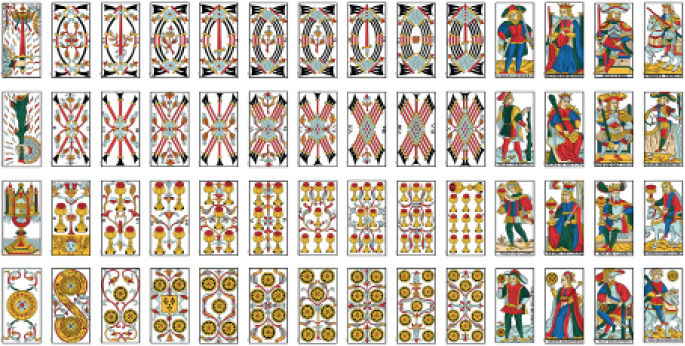
Fig. 1
The Minor Arcana
On the previous image we preesent the 56 cards in order. If we analyze this structure in detail from a numerological point of view, we find a whole made up of 14x4, that is, 56 elements.This subdivsion is easy, because the Tarot itself suggests it. In fact, our choice is not arbitrary but dictated by the nature of the global composition of the cards, composed in a simple and evident manner by 4 series of 14 elements each. Another important detail, is that the number 4 appears various times: 4 suits, 4 Courts, and 14 cards per suit (10+4 units).
This number in traditional symbolism is tied to the square, which has in fact 4 sides, and is associated with the Earth, as opposed to the Heavens, the spiritual world, represented by the circle. Thus, such an abundant presence of the number 4 would seem to suggest a tie between the Minor Arcana and the terrestrial world. Why? We must ascertain the correctness of this hypothesis and its meaning. In fact, from the first steps in the study of the Tarot, in order to not risk personal and subjective interpretations, it is necessary to entrust ourselves contantly to proveable and objective elements.
Firstly, it is worthwhile to know that in order to understand the symbolism it is not necessary to know complex problems or have particularly qualified and specialized notions, quite the contrary. In the case cited here, for example, we could certainly say that the philosopher Plato considered the square and the circle absolutely beautiful in themselves. According to this vision, the first would refer to the materialization of ideas, thus expressing phenomena and tangible reality; the second, vice versa, would represent the spirit, the world of superior ideations, of the Archetypes, All this, while potentially shareable, does not help us to understand why these two geometric figures were chosen to represent Heaven and Earth. In fact, in order to understand the symbolism made of images, codified by the Ancients, it would be well to appeal, first of all, to simplicity.
Every truly traditional symbol contains, apart from the generally known exterior meaning, a superimposed esoterical aspect, accessible only to those who have arrived at a certain degreee of knowledge. Their great keys of access are naturalness, clarity and semplicity, which oppose complexity. We do not intend to say that this is all easy, but only to mainain that the roots of symbolic knowledge must be grounded in the terrain of evidence in order to then bring nourishment to the highest, most fragile fronds of a vaster comprehension.
In the case of the square and the circle, therefore, it is enough to reflect upon their form. We have said that the first is composed of 4 sides, which represent the 4 elements of the material world: earth, water, fire and air, in which we live and by which we are surrounded and which, as we are about to see, are in close rapport with the symbols of the Minor Arcana; it is a stable, solid and “rooted” figure, and for this reason leads to the terrestrial. The second leads instead to the Heavens, to that celestial vault which appears to us, as it did to our ancestors thoousands of years ago, as they lay in the fields, observing the stars. These are the reasons why, for example, a church, which is a place of conciliatioon between matter and spirit, is built in a square and surmounted by a cupola, a circular element.
The 4 suits: Pentacles, Cups, Wands and Swords
The Minor Arcana, which, as already noted, in their basic organization possess a preponderance of the number 4, seem to have a close rapport with the terrestrial world, itself formed of 4 principles. We aim to verify if there does exist a connection between the 4 elements of nature and the suits of the cards. The notion of the 4 elements has been used since antiquity, for example by the presocratic philosophers (Thales, Anaximenes, Anaximander, Pythagoras, Parmenides, Diogenes, etc, to name only the most famous) or in a later age, Aristotle himself. Even the Alchimists of the middle ages formulated the hypotheses according to which the elements earth, water, fire and air were the basic principles of our world.
Actually, it was not an exclusively Western teaching but had a more general valence, being known also to oriental traditions, such as the Hinduist or the Buddhist, to mention the better known. Briefly, this doctrine avers an esoteric decomposition of the world into these four factors, which would be the bricks of the foundation of our physical universe. Instead of accepting this version simply because we are told that it is true, let us see if this is all confermed by the Tarot. First of all, we repeat, the Minor Arcana are divided into four series as are the four elements. As there is a first clear relation with the terrestrial, material and physical world, let us verify the possibility of greater consistency of this analogy. We know that the Minors are divided into Pentacles, Cups, Wands and Swords. What does this signify at a symbolical level? Observe the clarity and the logic of the following Codes, of these puzzles which permit our first step into the Coded Structure with which we will concern ourselves in the next chapter.
What do we use Cups for, in our daily lives? If we think of the modern equivalent, the answer is immediately evident. As glasses are used for drinking, Cups contain liquid: water, the quintessential liquid. As we look at the first card of the series, the Ace of Cups (as is correct when studying the Tarot), something emerges which facilitates the evaluation. Let us observe for a few moments the following illustration: the water gushing from under the great chalice is a delicate wink of the Tarot to confirm our suppositions. Always remember, these images are to be examined, first of all, with our eyes!
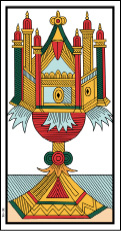
Fig. 2
Ace of Cups
As they are coins (and in fact are sometimes called Coins), made of gold. we may determine an evident connection with the earth, gold being a mineral present in the soil. If we desire a confirmation in this case also, suffice it to observe the Ace of Pentacles which, as the preceding Ace of Cups, shows another clue: from the great golden disk roots and flowers grow, creating an obvious connection with...the earth! All this is coherent and clear; and all considered, we could say that the first two symbols have been decodified and understood with great ease.
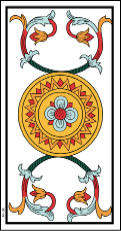
Fig. 3
Ace of Pentacles
Regarding the Wands, instead, we must search with more attention. For the Ancients, what was a possible and practical use for wood? This element burns, producing fire. In this case as well, if we observe the following card, the Ace of Wands, we will discover how the Tarot, by the presence of sparks around the the large central wand, fully confirms our supposition.
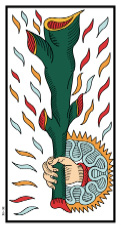
Fig. 4
Ace of Wands
Finally, for the Swords, the recognition is more difficult. Regarding this we should keep in mind that in the Tarot, when there is a group of four factors, the first two are easy to find, the third a bit less, and the fourth quite difficult. This is a diffculty scale to be found frequently and which corresponds to a precise rule, which we will examine in another context, called The Law of Quadruplicity or the Law of 3+1 . In the case of this last symbol, reflecting upon its use, we discover that in order to be correctly used, it must cleave...the air! Here then, the last relationship is evident. In any case, as in the aforementioned difficulty scale based on the Law of 3+1 , the Ace of Swords as well, which we might have expected to offer confirmation as did the first 3, sets itself apart from the others, becoming the exception. Thus, this is the sense of the rule: 3 elements are the same and one, in the area of the same dynamic, is different. In this Ace, then, instead of finding a clear symbol of the air, we find again, although with differnces it is too early to speak of, fire - as for the preceding Ace of Wands.
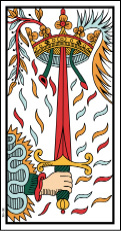
Fig. 5
Ace of Swords
With this brief analysis we have discovered, in the Tarot as well, the four elements water, fire, earth, air, perfectly represented by the four series. We reassume all in the following table:

In order to comprehend the richness of the symbolism of these Icons, and its absolute universality, let us compare the Hindu castes and the four series of the Minor Arcana, seeking some connection between the two. This interesting parallelism, in fact, may open the door to a vaster understanding, not only of the specific argument we are examining, but also of the history of the Tarot in general. In the structure of the Minor Arcana, the “figure” cards are characterized by being four, each representing a different personage. What connection may these have with the Castes? The Priests, Bramanas , may be associated with Cups containing liquids, as the chalice is, by definition, one of the more important symbolic elements of rituals. Speaking of which, this is confirmed not only in Christian rites but in Janism 42 as well, in which it was used in votive ceremonies. Water itself-associated with Cups-is a purifying element in all traditions.
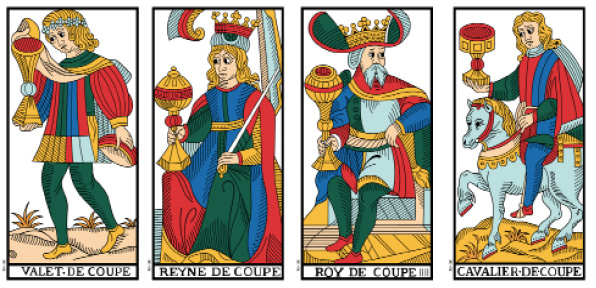
Fig. 6
The Suit of Cups
Warriors, the Kshatriyas , who fight using arms, as may be easily understood, are connected to Swords.
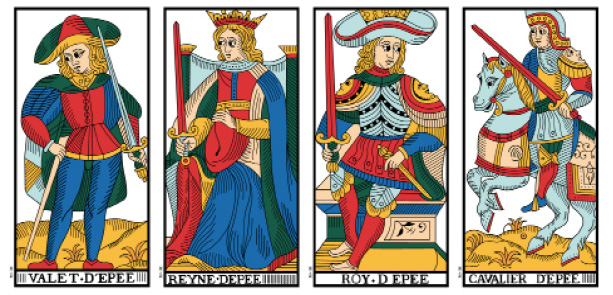
Fig. 7
The Suit of Swords
And for Merchants, the Vaishyas , who carry out their jobs using money, the rapport with Pentacles (Gold) is just as obvious.
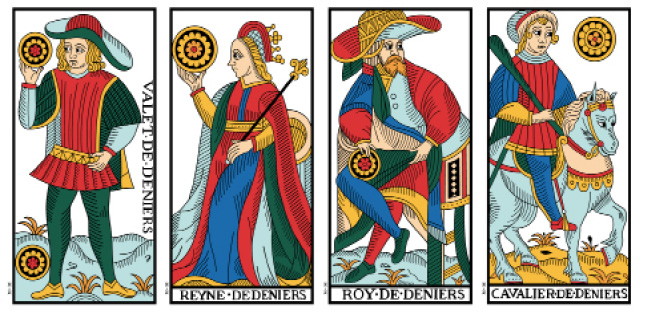
Fig. 8
The Suit of Pentacles
For workers, the Shudras , fully respecting the principle of the Tarot according to which the last element of a sequence of four is the most difficult to understand, the juxtaposition is articulate. As those who work handle tools and use energy, they are associated with Wands, an explicit symbol which recalls the concept of work and of fire, as expressly indicated, not only by the sequence itself, in which figure personages such as the Page and the Knight, represented, as were the ancient builders, in the act of measuring, but also by the first card, the Ace, in which is depicted a large staff of wood, clutched in a fist, surrounded by sparks, that is- energy (fig. 4).
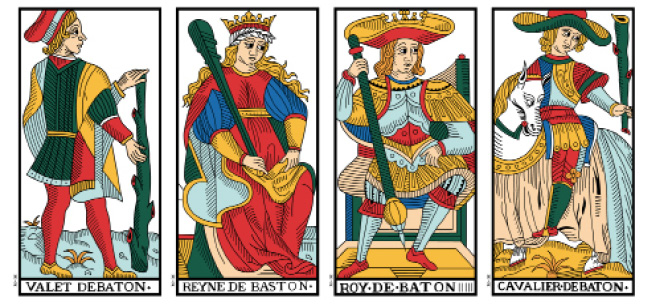
Fig. 9
The Suit of Wands
As we know that the four suits of the Minors, as well as the organization of castes, reflect the symbolism of the element of nature, we arrive at the following conclusions:
Air → Swords → Warriors
Earth → Pentacles → Merchants
Water → Cups → Priests
Fire → Wands → Workers
Demonstrating the perfect parallelism between the 4 suits, the 4 elements and the 4 castes, we have determined the following:
1) The symbolism of the Tarot is universal and brings confirmation and information, also regarding other Traditions.
2) There exists a rapport between something ancient and of very distant geographical extraction with respect to Western doctrines (in this case, Hinduism), which confers a widening of horizons and may stimulate new historical reflections regarding the Ancients.
In soon-to-be published works we will investigate these themes more deeply but for the moment, hoping to have satisfied part of your curiosity, we will now proceed to the analyisis of the general structure of the Major Arcana, which form the other great group of the Tarot.
Putting aside the 56 Minor Arcana, we are left with 22 cards. These, called the Major Arcana, are 21 cards numbered in Roman numerals from I to XXI, except one, the Fool, which has no number. Why? As we saw for the Minor Arcana, the distrubution of the Major also follows a criterium founded on logic. Let us begin with a first consideration: although they are 22 units. that does not mean that this number is fundamental. It may seem an unimportant point, but to underestimate it would be a serious mistake. In fact, the idea that this number might be of particular importance generated the conviction, on the part of esoterists of past centuries, that it was necessary to associate the cards to the Cabala and to the 22 letters of the Hebrew alphabet: this was one of the most glaring errors of the past. The Tarot, actually, has no need to be explained through the Cabala nor by any other sacred text; because, being itself a silent book composed of images, it is perfectly independent, containing, in the thousands of pages to decodify, every indispensale explanation.
What then must be our reasoning? If the total of the numbered Major Arcana is not 22 but 21, there must be a reason. We wish to stress that this mode of thinking, with respect to the Tarot, is quite new. In fact, since the Fool has no number, in many decks it has been initialed with the symbol “0”. These authors, unaware of the Coded Structure , believing the personage to indicate the totality and circularity of being, numbered it thinking to correct an imprecision present in the cards, without realizing that its absence is quite meaningful. In fact, why not judge it to be a precise and voluntary indication intentionally inserted by the ancient creators of the Tarot? If it has no number, it means that it is not part of the group of cards numbered 1 to 21 and therefore stands alone. Inferring simply in this manner, we find ourselves, as in mathematics, with two well-defined groups of Arcana:
1st group: The Fool
2nd group: the cards from 1 to 21
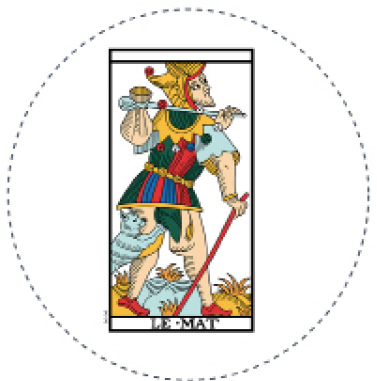
Fig. 10
Group without number: the Fool
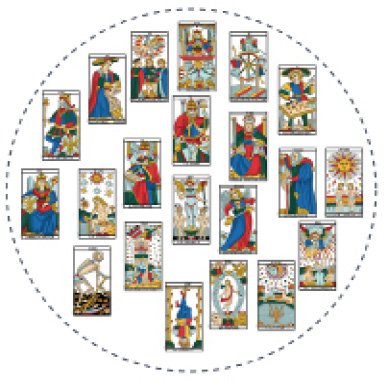
Fig. 11
Group of numbered cards
Let us now reflect on the 21 cards in order to understand the function of the Fool. How to proceed? Having imagined a logic, let us endeavor to apply it.
With respect to the entire structure of the Tarot, we have seen that the composition of the Minor Arcana awakens no perplexity. In fact, as in the best puzzles, where a part of the solution is already given to provide a basis of reference, let us use what we already know. We know that their total is divisable by two numbers, 4 and 14:
14
x 4 = 56 Minor
Arcana
And if it were possible to do the same with the Major Arcana? That is, if this group also might be divisible by two numbers? Using 21 and not 22 (!), we find that the only possible combination is offered by 3 and 7:
3x7
= 21 Major
Arcana
Proceeding in this way we arrive at the disposition of the cards according to a very precise scheme, a Diagram, 44 which allows the revelation of the presence of the Coded Structure of the Major Arcana. This order follows:
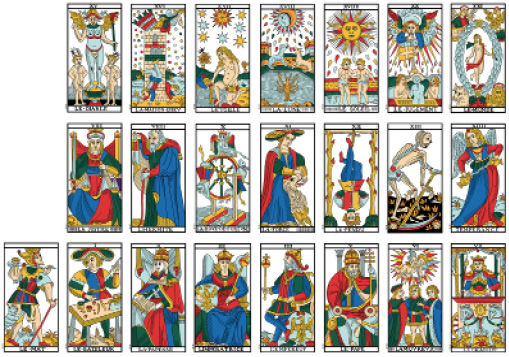
Fig. 12
The 3x7 Diagram
We will fully study this Diagram, called the Triple Septenary, in the next chapter. However, from what has been said already, it appears evident that the general peculiarity of the MajorArcana (which indeed follows this distribution) is the connection to the numbers 3 and 7, two sacred numbers in close relation with each other and with the spiritual world. This is not an unimportant aspect because, in this way we discover that if the Minor Arcana possess a close tie with the terrestrial world, the Major have a precise connection with the celestial, already evident from an overview, by the “supernatural” characteristics of the design.
Minor Arcana → Terrestrial World.
Major
Arcana
→
Celestial
World.
What is possible to learn from comparing these two groups of cards? Why do they propose this connection between Earth and Heaven? Before we can answer, we must introduce another essential theme: Dualism.